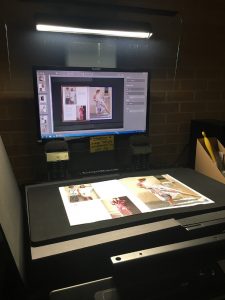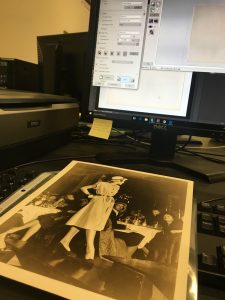Written By Raul Gonzalez
The Digital Projects Unit at UNT is responsible for the digitization of materials into UNT digital collections. This includes The Portal to Texas History, Texas Digital Newspaper Program, and UNT Scholarly Works, to name a few. Recently, I have been volunteering in the lab to digitize items from The Page Boy Maternity Collection for inclusion into The Portal to Texas History. In doing so, I have learned?how?digitization preserves?history in context?which leads to a deeper understanding of the past, in this case from a fashion perspective.
Digitization in Libraries

Photo by Raul Gonzalez
An important aspect of digital collections is that it can allow us to understand our past community and culture with context. There are history books you can read for major events of the past, but do you know how these events impacted your local area? How did your hometown reflect cultural events during a certain era? Libraries?have the ability to?incorporate and preserve these instances through digitization. This process assists in the transfer of knowledge between people and their understanding of societal history. It allows us to learn our history in a deeper sense.

Photo by Raul Gonzalez
The Frankfurt Sisters and their Page Boy Maternity Label
In 1938, sisters Elsie, Edna, and Louise Frankfurt created Page Boy Maternity, a Dallas, Texas based fashion label focused on maternity fashion. Page Boy introduced a new style of maternity clothing that progressed the changing perspective of pregnant bodies in a public or professional setting.By creating a garment that was capable of being customized to the changing pregnant body, they found a way for women to dress stylishly. Prior to their contribution, pregnant fashion was often hidden or uncomfortable. However, their impact on maternity clothing allowed pregnant bodies to be fashionable and admired in the public eye. Their collection grew to be successful and even found the likes of Jacqueline Kennedy. The reign of Page Boy ended in the 1990s after struggling to compete with other fashion brands, the increasing cost of producing garments, and management changes.
The Frankfurt Sisters’ story is arguably beyond their contribution to the fashion industry. Their action to take Page Boy Maternity to such great feats was an inspiration to female entrepreneurship, especially during the late Great Depression era. Page Boy is also embedded in a multitude of successful Jewish immigrant businesses that Dallas welcomed during the nineteenth century?(Goldman, 2013). The rich history of The Frankfurt Sisters and their Page Boy company offer value in fashion research. For this reason, photographs and catalogues from this collection are making its way into The Portal to Texas History. From there, researchers can view items digitally. As stated before, the inclusion of these materials allows researchers to understand Page Boy within historical and social context.The Portal to Texas History
The Portal to Texas History (PTH) is a collection that houses over a million digitally reproduced items of Texas history. These items include photographs, maps, newspapers, letters, and more. The mission of PTH is to provide rare, primary sources to life-long learners, researchers, and you! Access is made possible by UNT Libraries’ Digital Projects Unit, but much of the content is available due to partnerships and collaborations from a variety of private collectors and museums throughout Texas. Besides viewing PTH for educational resources, I like to search through this collection just out of pure curiosity.Much of UNT’s history is digitized and available for viewing. For example, you can find photographs of UNT when it was recognized as North Texas State Normal College in the 1900s. Perhaps the most interesting item I’ve found is the digitized speech delivered by President Chilton from 1890 . You can also find historical patents for inventions from Texas residents. Check out this patent for a Burglar Alarm from 1913.
The extensive history of Texas is just one click away. What can you find?
Feel free to leave suggestions or comments on our comments box below or email us at Askus@unt.eduReferences
Goldman, K. (2013). Dressing Modern Maternity: The Frankfurt Sisters of Dallas and the Page Boy Label. Lubbock, Texas: Texas Tech University Press.
Mallan, K., & Park, E. (2006). Is Digitization Sufficient for Collective Remembering? Access to and Use of Cultural Heritage Collections. Canadian Journal of Information & Library Sciences, 30(3/4), 201–220. Retrieved from https://utorontopress.com/ca/canadian-journal-of-information-and-library-science
Niu, J. (2014). Appraisal and Selection for Digital Curation. International Journal of Digital Curation, 9(2), 65-82. doi: 10.2218/ijdc.v9i2.272



Leave a Reply